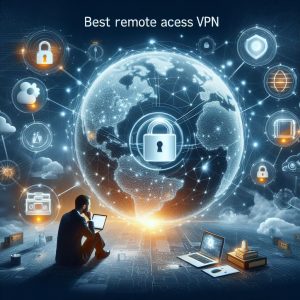Introduction
A remote access VPN allows users to securely access a private organizational network from a remote device over the public internet. This creates an encrypted tunnel to protect data transmitted between the device and network.
Remote access VPN capability has become extremely important for businesses, government agencies, and other institutions with distributed workforces. It allows employees to access internal resources, files, apps and tools no matter where they are located, supporting remote work initiatives.

How Remote Access VPN Works
A remote access VPN works by establishing a secure virtual tunnel using encryption across the public internet between the user’s device and the gateway of the organization’s on-premises private network. Any remote user with the proper credentials can connect via VPN tunnel.
Advanced protocols like IKEv2, SSL, and TLS are implemented which leverage both symmetric and asymmetric encryption methods using algorithms like AES, RSA, ECC, SHA256+ to authenticate the remote device and user while securely negotiating session keys. This ensures no outsider can eavesdrop on the VPN traffic.
Once properly set up and connected via VPN client software (configured with required VPN parameters and credentials), the remote device has direct pathway to access resources on the private network as if it were physically present within that network’s perimeter.
All traffic inside that encrypted VPN tunnel – emails, chat sessions document transfers etc – is fully secured since PKI encryption ensures only the VPN gateway endpoint can decrypt and read the data packets. This protects enterprise data from interception.
Key Features of Remote Access VPN Effective business-class remote access VPN solutions offer a variety of advantages:
- Secure encrypted access pathways (often referred to as VPN tunnels) specifically into private intranets and internal resources that remain protected from external access. This includes internal websites, cloud servers and storage, operational databases that organizations rely upon to function and conduct business.
- Support for simultaneous VPN connections from a variety of employee or third-party devices – whether managed mobile devices powered by Android or iOS or BYOD machines running Windows, mac OS, or Linux desktop platforms.
- Capability to select VPN connection entry points in different geographic server locations around the world to reduce latency and improve reliability of the VPN access experience. This ensures quality performance regardless of where globally an employee travels.
If VPN connectivity from a specific region struggles due to distance, network congestions or intermittent ISP problems, remote users can manually switch to alternate VPN server endpoints in a better location.

The best solutions integrate seamless failover capabilities that automatically and quickly reroute VPN traffic through alternative server access points globally if one endpoint server becomes unresponsive or overloaded.
Challenges to VPN-based Remote Access Despite the clear security and access advantages VPN delivers for remote users, VPN-centric remote access approaches also pose some inherent technology limitations that create security risks:
- Remote users transmit data from laptops, phones, tablets and other devices impossible for corporate IT teams to comprehensively track and control. This greatly increases vulnerability surface from malware risks, data leaks, or breaches impacting these user devices remotely.
- Remote devices often operate from unsecured Wi-Fi networks like cafes. Man-in-the-middle attacks could allow interception of even VPN traffic. Similarly, VPN encryption may be broken in future (e.g quantum computing). So additional layers of protection remain necessary beyond VPN alone.
Best Practices for Secure Remote Access
To maximize security for remote access to sensitive organizational resources, network administrators and CISOs recommend implementing a layered “defense in depth” approach with these best practices:
- Employ an Enterprise-Grade Commercial VPN
Rather than basic VPN tools built into operating systems, use a reputable commercial VPN solution purpose-built to secure corporate networks with the latest tunneling & encryption protocols for integrity/authenticity checks on traffic. - Enforce Two-Factor Authentication (2FA)
Employers should mandate 2FA over only using passwords for all corporate remote access which adds an additional credential check via OTP token, biometrics etc ensuring user legitimacy . - Implement Strong Password Policies
Enforce password complexity rules, expiration periods, and account lockouts after failed login attempts to prevent unauthorized access by cybercriminals into VPN connections. - Regularly Patch and Update Software/OS
Make certain all operating systems, software, network infrastructure, and VPN solutions deploy latest security patches/updates in a consistent manner to eliminate vulnerabilities. - Educate Remote Employees on Responsible Security Practices
Train remote employees through security awareness programs focused on topics like password hygiene, voicing phishing attacks, staying updated across personal devices, and reporting problems proactively to IT teams promptly.

Alternatives to Remote Access VPN Other innovative models have also emerged to make remote access even more seamless and secure for modern work environments:
Secure Access Service Edge (SASE) – SASE converges SD-WAN architectures integrating VPNs and Zero Trust Network Access (ZTNA) for context-aware user/device verification, more seamless cloud integration, and decentralized connectivity.
Zero Trust Remote Access – The zero trust framework enhances security by dynamically scrutinizing each user/device attempting access on a per-session basis before granting least-privilege access, rather than keeping VPN connections persistently open as privileged pathways in the network perimeter unchecked between active use sessions.
Conclusion
Secure and efficient remote access has become a pivotal IT priority. Integrating a dedicated remote access VPN capability using reputable provider with advanced encryption tunneling and authentication mechanisms remains the most ubiquitous and natively-supported approach to enable workforce mobility.
However additional security layers like SASE and Zero Trust solutions help overcome VPN limitations in today’s distributed work landscape with users and data dispersed across devices, networks and cloud platforms. Following best practice guidelines for deployment ensures remote users get needed access while protecting precious enterprise resources.